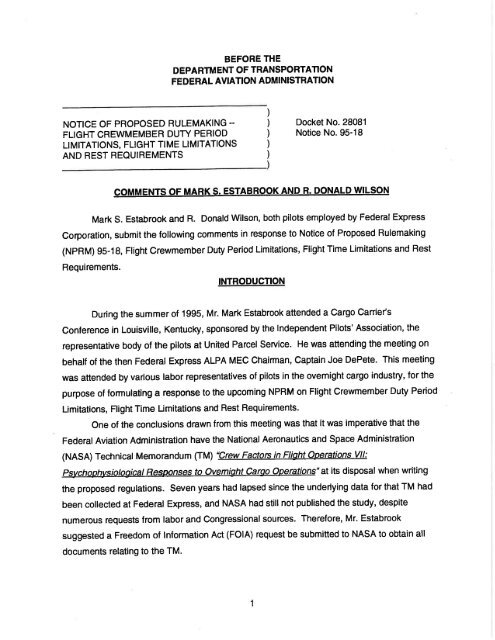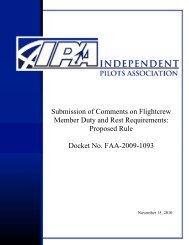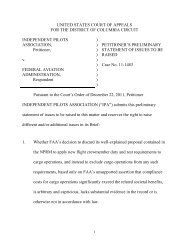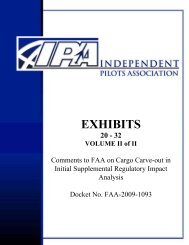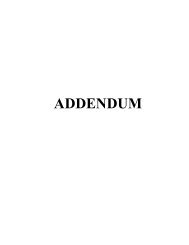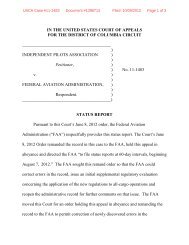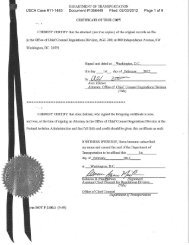NOTICE OF PROPOSED RULEMAKING - FLIGHT CREWMEMBER ...
NOTICE OF PROPOSED RULEMAKING - FLIGHT CREWMEMBER ...
NOTICE OF PROPOSED RULEMAKING - FLIGHT CREWMEMBER ...
You also want an ePaper? Increase the reach of your titles
YUMPU automatically turns print PDFs into web optimized ePapers that Google loves.
BEFORE THE<br />
DEPARTM ENT <strong>OF</strong> TRANSPORTAT]ON<br />
FEDERAL AVßNON ADMINISTRATION<br />
<strong>NOTICE</strong> <strong>OF</strong> <strong>PROPOSED</strong> <strong>RULEMAKING</strong> -<br />
<strong>FLIGHT</strong> <strong>CREWMEMBER</strong> DUTY PERIOD<br />
LlM¡TATIONS, <strong>FLIGHT</strong> TIME LIMITATIONS<br />
AND REST REQUIREMENTS<br />
)<br />
)<br />
)<br />
)<br />
)<br />
Docket No. 28081<br />
Notice No. 95-18<br />
COMMENTS <strong>OF</strong> MARK S. ESTABROOK AND R. DONALD WILSON<br />
Mark S. Estabrook and R. Donald Wilson, both pilots employed by Federal Express<br />
Corporation, submit the following comments in response to Notice of Proposed Rulemaking<br />
(NpRM) g5-18, Flight Crewmember Duty Period Limitations, Flight Time Limitations and Rest<br />
Requirements.<br />
INTRODUCTION<br />
During the summer of 1995, Mr. Mark Estabrook attended a Cargo Caniet,s<br />
Conference in Louisvilte, Kentucky, sponsored by the lndependent Pilots' Association, the<br />
representative body of the pilots at United Parcel Service. He was attending the meeting on<br />
behalf of the then Federal Express ALPA MEG Chairman, Captain Joe DePete. This meet¡ng<br />
was attended by various labor representatives of pilots in the ovemight cargo industry, for the<br />
purpose of formulating a response to the upcoming NPRM on Flight Crewmember Du$ Period<br />
Limitations, Flight Time Limitations and Rest Requirements.<br />
One of the conclusions drawn from this meeting was that it was imperative that the<br />
FederalAviation Administration have the NationalAeronautics and Space Administration<br />
(NASA) Technical Memorandum (TM) "Crew Factors in Flight O<br />
psychophysiotogical Resoonses to Ovemight Cargo Operations"at its disposal when writing<br />
the proposed regulations. Seven years had lapsed since the underlying data for that TM had<br />
been collected at Federat Express, and NASA had stillnot published the study, despite<br />
numerous requests from labor and Congressional sources. Therefore, Mr. Estabrook<br />
suggested a Freedom of lnformation Act (FOIA) request be submitted to NASA to obtain all<br />
documents relating to the TM.
The attached documents to this submission include copies of the exchange of<br />
conespondence between Mr. Estabrook and NASA officials from September 1995 through<br />
March 1996. After exhausting all FOIA appeals with the NASA Administrator and his General<br />
Counsel, Mr. Estabrook filed suit in Federal Court to seek relief from NASA's denial of his FOIA<br />
request. A copy of that complaint immediately follows these comments for your<br />
Administration's inspection. This suit was funded by the lndependent Pilots Association, due<br />
to its mutual interest in "back side of the clock" scheduling and flight safety.<br />
During the litigation of the FOIA lawsu¡t, NASA agreed to release certain documents in<br />
its possession. Some of those responsive documents include earlier drafts of the TM, as well<br />
as NASA conespondence, which are all attached as Appendix D to these comments.<br />
COMMENTS <strong>OF</strong> MARK S. ESTABROOK<br />
The FAA's proposal to amend existing regulations to establish one set of duty period<br />
lim1ations, flight time limitations, and rest requirements for flight crewmembers engaged in air<br />
transportation flies in the face of the conclusions published by NASA in the August 1994<br />
Technical Memorandum (TM) "Crew FaAorc in Flight O<br />
Responses to Overnight Cargo Operations.' FoÍ example, NASA concludes in this study that:<br />
"Flying at night required crews to sleep during the day. Daytime sleep episodes were about<br />
3 hrs (41o/") shorterthan nighttime sleep ep¡sodes, and were rated as lighter, Iess<br />
restorative, and poorer overall. The incidence of sleeping more than once in 24 hrs tripled<br />
on days with duty, compared to days without duty. Overall, crew members averaged 1.2<br />
ñrs /ess sleep per 24 hrs on duty days than on pretrip days. Laboratory studies suggest<br />
that this steep restríction, combined with the poorer sleep quality, would decrease<br />
waketime aleftness progressively with the number of days of reduced sleep."<br />
Although NASA scientist Dr. Mark Rosekind was one of the authors o! "Crew Factors in Flight<br />
Operations Vlt,"he also co-authored another 1995 NASA Technical Memorandum<br />
entitled<br />
'"that<br />
included guidelines and recommendations which the FAA adopted in its cunent NPRM. ln<br />
"@,"RosekindseemStoignoretheresultsofhisownpreviousworkin<br />
"Crew Factors in Ftight " as detailed in the last paragraph of the operational<br />
overview:<br />
2
'These data, collected during scheduled flight operations, support the conclusion that<br />
nighttime ftying imposes different physiological challenges than daytime flying. Wherevel<br />
possibte, these differences should be taken into account in trip construction, with particular<br />
.attention<br />
being gíven to the timing and duration of rest periods, and the number of<br />
consecutive nights of flYing.'<br />
After reviewing the NASA research, there appears to be a risk to safety if current<br />
scheduling practices at Federal Express and perhaps other'ovemighf caniers continue. I see<br />
no relief from that risk to safety by this NPRM. ln fact, I see MOHE of a threat to safety if this<br />
NPRM is implemented.<br />
'l also believe that Dr. Rosekind was asked to author "Principles and Gt)i<br />
,' at a<br />
¡me when he authored scientific conclusions significantly different for overnight cargo pilots.<br />
The data is so different between the two groups of pilots that it seems impossible to write<br />
homogenous scheduling guidelines; it seems implausible NASA would overlook the significant<br />
differences. Thus, 'back side of the clock" scheduling regulations could not be adequately<br />
addressed in "Principles and Guid ." ln fact, the FAA's proposalto amend existing<br />
regulations to establish one set of duty period limitations, flight time limitations, and rest<br />
requirements for flight crewmembers engaged in air transportation appears flawed from the<br />
beginning. "One size fits all" scheduling regulations cannot be tailored to ovemight cargo pilots<br />
and their daytime counterparts simultaneously. Each type of flying places different demands<br />
on safety.<br />
Both NASA and the FAA must feel industry pressure to have upcoming changes in<br />
FARs minimize costs and increase productivi$. Such goals may be so far in opposition to<br />
public safety that a third party such as the NationalTransportation Safety Board, Congress, a<br />
Federal court, orthe media might have to intervene on behalf of ovemight cargo or late-night<br />
passenger carrying pilots.<br />
Consider the following conclusions from "Crew Factors in Flight O<br />
':<br />
"tf tate off-duty times are unavoidable, then layovers need to be longer (the present data<br />
suggest at teast 19 hours), to accommodate a second sleep episode in the evening.'<br />
The FAA's proposed FARs will result in an increase in flight and/or duty time with a<br />
corresponding decrease in crew rest for overnight cargo pilots, while NASA research demands<br />
the exact opposite. ls this why "back side of the clock" flying is not being addressed in this<br />
NPRM NASA scientific conclusions suggesting 19-hour layovers for late off-duty times, for<br />
3
example, are not found in this NPRM, and if implemented, might cause industry officials to<br />
belabor the costs ad infinitum. Nevertheless, NASA suggests 19-hour layovers are<br />
scientifically necessary.<br />
Although politically expedient phrases such as "One Level of Safety" sound appealing<br />
to the general public, those of us who fly high speed jets on the "back side of the clock" around<br />
the wofd know such slogans ring hollow and are not scientifically founded. Flying at night and<br />
sleeping during the day produces a larger accumulated sleep debt, which, when compounded<br />
over time, creates unsafe flight cònditions for crews, passengers, and the general public. This<br />
is well-established by NASA research on fatigue related performance decrements, and can be<br />
compared to drunken or sedated pilots at the controls of aircraft. Therefore, the FAA's<br />
exctusion of .back side of the clock" flying and its related scientific research from the NPRM<br />
will significantly and adversely affect flight safety.<br />
The exclusion of relevant scientific research is ironic, considering much of the pressure<br />
on the Administration to revise the relevant FARs was due, in part, to the results of an accident<br />
investigation conducted by the National Transportation Safety Board (NTSB) at Guantanamo<br />
Bay, Cuba. The NTSB cited scheduling FARs as a contributing factor in that crash, further<br />
burdening the FAA with the need to revise flight and duty time regulations. The NTSB<br />
recommended the FAA:<br />
"Expedite the review and upgrade of flight/duty time limitations of the Federal Aviation<br />
Regutations to ensure that they incorporate the results of the latest research on fatigue and<br />
sleep.'<br />
I feelthis NTSB recommendation is being ignored in this NPRM.<br />
The critical August 1994 NASA Technical Memorandum (TM) "Crew Factors in Flight<br />
Ooerations Vtl" must be added to the body of NASA scientific research upon which the NPRM<br />
is based, since it is the previously stated intention of the Administration to rely upon applicable<br />
NASA research.<br />
Since the documents obtained in my FOIA lawsuit against NASA reveal that the<br />
conclusions contained in the August 1994 draft of the Technical Memorandum (TM) "Crew<br />
Factors in Ftight Operations Vll" were apparently revised due to special interest<br />
communications between NASA researchers and Federal Express Corporation, I contend that<br />
atl other subsequent drafts of the August 1994 NASA (TM) "Crew Factors ¡n FIigft<br />
!!!!,"including the December 1995 and February 1996 versions, be disregarded by the FAA in
its construc'tion of Flight Crewmember Duty Period Limitations, Flight Time Limitations and<br />
Rest Requirements. I am shocked that the scientific method at the Ames Research Center<br />
seems to have been compromised in favor of "special interest science." ln fact, aJanuary 27,<br />
19g5 letter to Branch Chiefs, Flight Management and Human Factors Division at the Ames<br />
Research Center, from the AF/Chief, Flight Management and Human Factors Division,<br />
specifying the "Publication Review Policy'for TMs, contains the following directive:<br />
'AIt pubtications MTJST be reviewed by the cognizant Branch Chief.' Your signature attests<br />
to the fact that you have reviewed the document and found it correct as far as possible,<br />
vatuabte in some sense, and a valid representation of NASA research. You should also<br />
ensure that the form FF427 for NASA HQ has been completed. ln addition, your revíew<br />
must ensure that Programmatic or "<br />
[Emphasis added]. [See Appendix D-17]<br />
lf the scientific researchers at NASA are required to be "politically conect," how can they avoid<br />
compromising the scientific method How can NASA TM reviews based on political<br />
conectness serve the public's interest in safety or the Administration's responsibility to write<br />
sound regulations<br />
The resutts of the study were delayed from the 1987-88 time period, when the data was<br />
initially collected, untíl December 1995, when the first of several "final" versions was published<br />
by NASA. Coincidentally, my first FOIA request of NASA forthe TM was sent in September<br />
1995. I can only wonder whether the TM would have been published prior to the end of the<br />
comment period for the FAA's NPRM without my FOIA request prompting NASA to publish it.<br />
When subsequent comparisons of the December 1995 version of the TM were made<br />
with the August 1994 version, I realized significant changes in the text had occurred. After<br />
numerous letters to NASA met with resistance, I was finally informed in March 1996 they would<br />
not comply with my request, and I was free to seek judicial review in the Federal courts.<br />
After receiving my complaint and a motion for preliminary injunctive relief and<br />
discussing the case with the Federaljudge assigned to the case, NASA reversed itself and<br />
agreed, out of court, to release documents it acknowledged to have in its position. I have<br />
attached the relevant documents for your administrative review and inspection, as well as<br />
forwarded copies to Federal Express Captain R. Donald Wilson for his comments below.<br />
5
COMMENTS <strong>OF</strong> R. DONALD WLSON<br />
I am a Federal Express DC-10 Captain. I was Assistant Chief Pilot, Flight<br />
Administration, from 1985 through 1988. ln that capacity, I was assigned the task of<br />
coordinating w¡h our pilots the NASA research for their Technical Memorandum (TM) "Crew<br />
Operations,"at Federal Express. I also served as the FedEx ALPA Master Executive Council<br />
(MEC) Chairman from February 1993 through January 1995, and commented to NASA on the<br />
August lgg4 "Crew Factors in Flight .'<br />
I have reviewed much of the material associated with "Crew Factors in Flight<br />
Operations Vtl." I have also reviewed the TM as presented to Federal Express and ALPA in<br />
August 1994 and the December 1995 TM.<br />
I have looked specifically at the October 4,1994letter from Mr. Clive Seal, Vice<br />
president, Federal Express Flight Operations, to Mr. Victor Lebacqz of NASA-Ames [See<br />
Appendix D-1OI ; my September 28, 1994 letter to Dr. Mark Rosekind of NASA-Ames [See<br />
Appendix D-gl; and Mr. Lebacqz's response to the Seal letter almost ayear later with the<br />
included "Detailed Response..." [See Appendix D-11]. I am both angered and amazed that a<br />
purportedly independent scientific study can be so easily compromised by the apparent<br />
acceptance at face value of remarks by a corporate party with profit at stake in the study. I<br />
believe the letters tell a clear story without too much comment from me, but I will provide you<br />
with nry obseruations in the interest of flight safety.<br />
As my letter to Dr. Rosekind states, I was the Assistant Chief Pilot who acted as liaison<br />
in setting up and administrating the fatigue study at Federal Express. There was a clear<br />
understanding that the data and scientific conclusions would be shared with all interested<br />
parties, would be unbiased, and woutd only keep confidentialthe actual identity of the study<br />
participants with their respective data. That confidentiality protected both the participant and<br />
his freedom to be candid about the subjective effects of fatigue on his performance (certain<br />
non-subjective biomedical measurements were gathered as well).<br />
I was shocked when, at the last moment, FedEx management attempted to exclude all<br />
but themselves from review of the draft TM. We at FedEx ALPA were subsequently afforded a<br />
separate briefing by Dr. Mark Rosekind. Both management and FedEx ALPA were then asked<br />
to comment on the study. Captain David Wells commented on behalf of the FedEx ALPA<br />
6
Safety Committee, and I submitted a synopsis of other pilot obseruations on behalf of those<br />
pilots present at the briefing.<br />
Sonny Thompson signed FedEx management's response on behalf of Clive Seal. I am<br />
doubtfulthat either of them actually composed most of the very technical response attributed<br />
to Mr. Seal.<br />
After reviewing both my comment letter and the Seal letter, I believe most Federal<br />
Express pilots would support my observations and conclusions. I would ask, however, that the<br />
Administration look at Mr. Lebacqz's almost blind acceptance of Mr. Seal's statements to the<br />
apparent exclusion of my comments. ln fact, I never received any acknowledgment of my<br />
comments at all, and I can only suspect that it is because they contrast with FedEx<br />
management's interests in greater productivity and lower costs.<br />
I would call attention to the second paragraph of the Seal letter, which states:<br />
u...we are constantly introducing new techniques and operational changes to reduce the<br />
demands on our crew members. We do so by listening to our crew members and our<br />
Ftight Safety Department, and by monitoring innovations within our industry.'<br />
That sounds nice, but ask most FedEx line pilots -- or a management pilot, forthat matter -- to<br />
point out the actual ways this statement has been applied. Management has actually<br />
discÍptined pilots for being fatigued. Perhaps FedEx thinks statements of philosophy,<br />
slogans, and CRM or corporate directives can alleviate the problems associated with circadian<br />
disruption and sleep debt accumulation. The actual application is more akin to uwe're going to<br />
teach you the meaning and terms of sleep deficit, and we're directing you to not be<br />
performance impaired due to fatigue.' The Administration must know that airlines cannot<br />
address human physiology with slogans and directives, but must instead rely on sound,<br />
scientific research and its application to flight operations.<br />
ln short, I do not believe there is any substance to the claims made in the Seal letter.<br />
We DO NOT have longer layovers to address circadian disruptior/shift; we DO have a<br />
management trying to push us to our limits. The NASA-Ames observers did not note<br />
"decreased performance" in the pilot subjects because they were specifically told NOT to<br />
evaluate "performance'since they were not Check Airmen. That left it to the pilot to freely<br />
evaluate any decrease in his own performance. While some d¡d, it is well known that selfrecognition<br />
of fatigue-related performance decrement can be as difficult as self-recognition of<br />
the results of hypoxia.<br />
7
Finally, and once again, I find it very troubling that FedEx management sought to inject<br />
itself into the results portion of the study -- both to deny pilot access to the draft and again in<br />
the close of the Seal letter. Even more problematic is the acceptance by NASA, at face value,<br />
of representations by management when contrary observations were also in evidence through<br />
Captain Wells and myself.<br />
I hope these observations are helpfulto the Administration. I think in most ways the<br />
attached letters speak for themselves. I believe most of our pilots, and certainly those of us<br />
who were study participants, would find the Seal letter void of real substance. With NASA's<br />
acceptance of that letter into the final TM, I view the published TM as tainted and in conflict<br />
with public safety.<br />
CONCLUSION<br />
It is our contention that the conclusions drawn in the final version of the Technical<br />
Memorandum (TM)<br />
Ovemight Cargo Operations"have been compromised by changes prior to its publication and<br />
distribution. Those changes were requested by FedEx management in their letter of October<br />
4, 1994 to Mr. Victor Lebacqz. Mr. Lebacqz accepted those changes and deletions without<br />
asking for supporting data from FedEx management, and without regard to other comments<br />
submitted by FedEx ALPA. Additionally, NASA's own publication review pol¡Gy, evidently<br />
directs such behavior by mandating lhat "political rssues are dealt with appropriately."<br />
The undersigned individuals, Mark S. Estabrook and R. Donald Wilson, request that the<br />
Federal Aviation Administration cancel implementation of NPRM Notice 95-18, Flight<br />
Crewmember Dug Period Limitations, Flight Time Limitations and Rest Requirements, until<br />
such time as the scientific conclusions contained in the August 1994 publication of the<br />
Technical Memorandum (TM) "Crew Factors in Flight O<br />
Responses to Overnight Cargo Operations"can be incorporated into the proposed Federal<br />
Aviation Regulations. Failure to do so will inevitably raise further legal review by the courts<br />
and Congress of the FAA's arbitrary construction of Federal Aviation Regulations in<br />
contradiction of its own previously stated public policy of reliance on relevant NASA scientific<br />
research. Submission of these comments, and the attached NASA TM, should place the FAA<br />
on notice that serious safety issues are at stake and that the lives of "overnight" pílots, their
cargo or passengers, and the populations they fly over may be at risk if the proposed NPRM is<br />
implemented in its current form.<br />
bmitted for Your<br />
dayofJune,1996.<br />
MARK S. ESTABROOK<br />
PO Box 1021<br />
Gordova, TN 38088-1021<br />
R. DONALD WILSON<br />
11103Wexford Dr<br />
Eads, TN 38028-9705<br />
I


